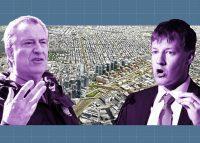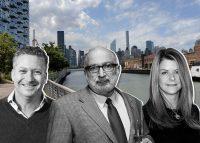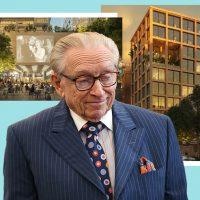For Eric Benaim, losing Amazon still hurts.
It’s been 19 months since the tech giant canceled plans for a 25,000-job campus in Long Island City, where Benaim’s brokerage is based. But now he has another chance, as developers have targeted the ex-Amazon site for up to 15 buildings of 37 to 64 stories, mostly commercial but also with 100 percent affordable housing, cultural space, job-training centers, as many as three public schools and seven acres of open space.
But that megaproject and two others proposed for Queens face the same community and political opposition that doomed Amazon.
Benaim and one of the city’s most powerful labor leaders, Kyle Bragg of 32BJ SEIU, appeared Wednesday on TRD Talks Live to make the case for the developments, which include another private effort, Innovation QNS in Astoria, and a public one over the vast rail site Sunnyside Yard.
Of the Long Island City project, called Your LIC, Benaim said, “I think it’s a really great, vibrant plan that offers 26,000 jobs, plus another 48,000 construction jobs at a time where I think New York City needs jobs and people need to work more than ever.”
But the projects all face criticism that they will cause gentrification and displacement, raise rents and alter the character of their neighborhoods, along with the traditional complaints about traffic and construction noise.
Read more



Bragg, whose union would likely represent many of the workers in the three projects’ buildings, is among the city leaders trying to counter the opponents’ narrative.
“We need responsible development,” said Bragg, whose union includes doormen and other building service workers. “We can continue to build good communities responsibly, communities that provide good family sustaining jobs” while constructing infrastructure to meet additional needs, he said.
Project opponents — including Council member Jimmy Van Bramer, state Sen. Michael Gianaris, Rep. Alexandria Ocasio-Cortez and the activist group Stop Sunnyside Yards — declined invitations to appear, so the moderator, TRD senior managing editor Erik Engquist, tried to characterize their thinking.
“They see inequities in the world, they see massive income inequality, they see high housing costs, and they see development” — and conclude that development causes those problems, Engquist said. Though economists disagree, the sentiment has been fueling anti-development movements, he said.
But adding housing should not increase its cost — quite the opposite, Benaim said.
“The less supply, the more demand, that’s what increases prices,” Benaim said. “The more development you allow … You’re going to flood the market with more units, and it’s going to bring down the prices. That’s simple economics.”
Bragg noted that the Sunnyside Yard project would bring 12,000 affordable homes, including 6,000 for very-low-income households. He called it an example of what the city needs.
Anti-development groups have gained momentum since Amazon’s pullout, thanks in part to election victories by Democratic Socialists of America–backed candidates. But others in the communities may finally speak up to support the projects, Benaim said.
“I think at the end of the day, you’re going to see all these projects win,” he said. “There’s so many people who are out of work right now. And people just need jobs.”